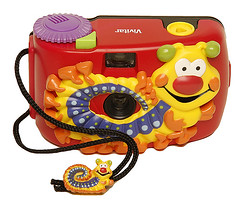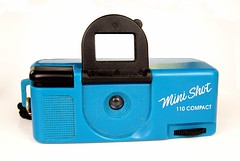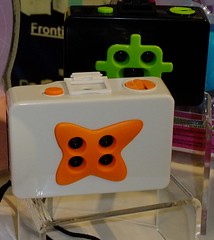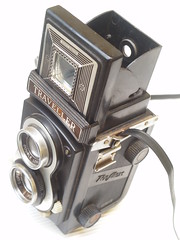Difference between revisions of "Toy camera"
(clarifying "Lomo" in this context) |
(Expanding & clarifying; blanked references that were sloppily cited without notes) |
||
| Line 21: | Line 21: | ||
| image=http://farm4.static.flickr.com/3208/3132014210_d0799f73d0.jpg | | image=http://farm4.static.flickr.com/3208/3132014210_d0799f73d0.jpg | ||
| image_align=left | | image_align=left | ||
| − | | image_text= | + | | image_text=So-called toy cameras: |
| − | [[Lomographic ActionSampler]], [[Holga]], [[Diana]], and [[Lomographic Fisheye Camera]] | + | [[Lomographic ActionSampler]], [[Holga]],<br/>[[Diana]], and [[Lomographic Fisheye Camera]] |
| image_by=Stefano | | image_by=Stefano | ||
| image_rights=with permission | | image_rights=with permission | ||
}}{{brl}} | }}{{brl}} | ||
| − | A toy camera is an inexpensive camera made almost entirely out of plastic, including the lens. They are usually made in China or the former Soviet Union | + | A '''toy camera''' is an inexpensive camera made almost entirely out of plastic, including the lens. They are usually made in China, Hong Kong, Southeast Asia, or the former Soviet Union. |
| − | Nowadays we could add | + | From an aesthetic point of view, it is the flaws of these camera's inferior optics which may sometimes become a sought-after effect: Corner blur, [[vignetting]], or spherical aberration may all lend images an atmospheric or moody quality which suits a photographer's particular vision. |
| + | |||
| + | The [[Diana]] and [[Holga]] are the cameras most associated with the term today, although neither were created as children's toys originally. The [[Lomography|Lomographic Society]] specializes in cameras that may be considered toys, with "lo-fi" optics or ones giving whimsical effects. (The company began by selling Soviet [[LOMO]] models with questionable optics.) | ||
| + | The dreamy effects of using toy cameras has been documented in plenty of photo exhibits, such as the annual "[http://www.sohophoto.com/krappy_kamera_comp.html Krappy Kamera]" show in the SoHo neighborhood of New York. | ||
| + | |||
| + | <!--If anyone would care to track down the exact titles and dates and footnote these correctly, please go ahead and add them back. | ||
| + | |||
| + | Various publications such as Photography magazine dated Fall of 1977 extolled the virtues of the Diana camera, a toy camera, in its own right as an "art" producing image maker. Several books have also featured the work of toy cameras, such as "The Diana Show, Iowa," and "Angels at the Arno" to name a few. | ||
| + | --> | ||
| + | |||
| + | Nowadays we could add many early-generation digital cameras to the category, e.g. for [[VGA]]-format images (640x480 [[pixel]]s) as well as many novelty keychain or pen cameras, or even the poorer of today's ubiquitous cell-phone cameras. In each case image pixelation, noise, and color response may be so flawed as to become an interesting, desired effect. | ||
=== Gallery === | === Gallery === | ||
Revision as of 22:05, 11 July 2011
| toy camera sample |
|---|
|
Maker: unknown Lens: single lens |

|
| So-called toy cameras:
Lomographic ActionSampler, Holga, |
A toy camera is an inexpensive camera made almost entirely out of plastic, including the lens. They are usually made in China, Hong Kong, Southeast Asia, or the former Soviet Union.
From an aesthetic point of view, it is the flaws of these camera's inferior optics which may sometimes become a sought-after effect: Corner blur, vignetting, or spherical aberration may all lend images an atmospheric or moody quality which suits a photographer's particular vision.
The Diana and Holga are the cameras most associated with the term today, although neither were created as children's toys originally. The Lomographic Society specializes in cameras that may be considered toys, with "lo-fi" optics or ones giving whimsical effects. (The company began by selling Soviet LOMO models with questionable optics.) The dreamy effects of using toy cameras has been documented in plenty of photo exhibits, such as the annual "Krappy Kamera" show in the SoHo neighborhood of New York.
Nowadays we could add many early-generation digital cameras to the category, e.g. for VGA-format images (640x480 pixels) as well as many novelty keychain or pen cameras, or even the poorer of today's ubiquitous cell-phone cameras. In each case image pixelation, noise, and color response may be so flawed as to become an interesting, desired effect.
Gallery

|
| Vivitar toy camera for 35mm film image by Rick Soloway (Image rights) |

|
| Polaroid toy camera image by Dusty Medusa (Image rights) |

|
| image by Kenneth Dwain Harrelson (Image rights) |
|
|

|

|
Links
- ToyCamera.com
- Official Site of the Lomographic Society International
- Diana Camera Site
- Photography Review's Toy Camera Reviews
- Picture Gallery using cameras such as Diana, Holga, Actionsampler etc www.picturenoise.com


